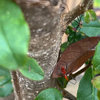Black Knot Fungus and non-toxic home made fungicide?
Hello,
I've recently inherited some fruit trees, Italian Plum and some kind of Cherry tree. These trees were neglected pruning wise and they have many branches that are infected with the Black Knot fungus. I've read up a lot about Black Knot and have begun to prune away 6" below the fungus. I still need to get up on the ladder to get the rest and to shape the trees.
Anyways I have a couple questions. First off, what do I do when the Black Knot is growing on the trunk or in a major limb/trunk intersection? Secondly is there anything non-toxic that I can mix up and spray on the trees? Like baking soda, milk, cinnamon or chamomile? From what I've read the suggestion is to use lime-sulfur or copper sprays, both which I refuse to use. So if anyone has any information/experience on handling Black Knot let me know.
Thanks.
Comments (41)
dchall_san_antonio
15 years agolast modified: 9 years agoI would not over think this, but while you are thinking about it, I would spray milk up there. My second choice would be liquid seaweed, but that choice is only second because it is usually harder to find and more expensive. Spray the entire tree from soil to new shoots on all sides until it is dripping. Repeat every two weeks.
The general solution to stuff like that is maintaining healthy trees. If compost has not been used in the past, start now. I would start by making sure the trees are not buried too deep in the soil (the root flare should be visible). If the root flare is not visible, use water to wash the soil away from the trunk. Then build a barrier to prevent the soil from coming back. Next, scatter a little compost directly on the ground under the tree canopy followed by heavy mulch. Make sure the mulch is not up against the tree (remember the root flare). You can mulch it several feet thick if you want to.
Kimmsr
15 years agolast modified: 9 years agoPruning out known infections, when tempertures are below 50 degrees, is the first step in control. However, since a branch can be infected now and not be observable until next year means spraying, in an attempt to control the spread of the spores, is also necessary and copper is the material of choice. For trees that might have galls on the trunk cutting them out is the only means of control.
Here is a link that might be useful: Cornell on Black Knot fungus
Related Professionals
Ashburn Landscape Architects & Landscape Designers · East Rancho Dominguez Landscape Architects & Landscape Designers · Manorville Landscape Architects & Landscape Designers · Saint Matthews Landscape Architects & Landscape Designers · Brunswick Landscape Contractors · Burien Landscape Contractors · Duarte Landscape Contractors · East Chicago Landscape Contractors · Lexington Landscape Contractors · Painesville Landscape Contractors · Soddy Daisy Landscape Contractors · Jupiter Decks, Patios & Outdoor Enclosures · Philadelphia Decks, Patios & Outdoor Enclosures · Royal Oak Decks, Patios & Outdoor Enclosures · Schaumburg Decks, Patios & Outdoor Enclosuresjustaguy2
15 years agolast modified: 9 years agoI guess the first question is why do you refuse to use proven solutions such as copper sprays?
I know of a person with stage 4 lymphoma who refuses treatment. In his mind the drugs that would be given to him to treat/cure the cancer are hideous and unhealthy. I am not going to disagree with him, but given that his cancer is 100% lethal if not treated and easily treated otherwise I don't understand his refusal to get treatment.
What is worse, taking a treatment that isn't healthy but will cure a lethal disease or dying from the curable disease?
It sounds to me like you have done plenty of research and already know copper sprays will cure the problem, but you want someone to tell you that chamomile tea will do the trick even though you know it won't.
I think you already know how to fix the problem, the only question is whether you will accept the treatment on behalf of your trees or you prefer to avoid the toxicity of the treatment and have your trees die.
Your call :)
gardengal48 (PNW Z8/9)
15 years agolast modified: 9 years agoSince various copper solutions as well as lime sulfur fungicides are approved for organic use (OMRI certification), I am also curious why you refuse to use them. Despite what you may think or what others may tell you, homemade remedies will have virtually no effect on black knot.....it doesn't even respond well to copper fungicides.
There is nothing magically non-toxic about organic disease controls - many approved organic products are as toxic as some synthetically derived pesticides. The degree of toxicity (and the toxic properties are what is killing off the disease pathogens) speaks loudly to their effectiveness as well. Milk and camomile may work moderately well against foliar diseases but their effectiveness is extremely limited against other fungal organisms.
I'd agree with Nandina - if approved organic fungicides like lime sulfur or copper sprays are out of the question (together with proper pruning and appropriate cultural controls), removing heavily infested trees is your best course of action.
dchall_san_antonio
15 years agolast modified: 9 years agoSince various copper solutions as well as lime sulfur fungicides are approved for organic use (OMRI certification), I am also curious why you refuse to use them.
My reason would be that copper and sulfur are poisonous to microbes. Just because they are in the organic catalog does not force you to use them.
gardengal48 (PNW Z8/9)
15 years agolast modified: 9 years agoNo one is forcing anyone to do anything. It was just a question, as these are approved organic controls. As to being poisonous to microbes, I'm not at all sure why that would be of any concern. The entire point of any pesticide - homemade remedies or not - is to direct specific toxic properties at specific problems. As copper or lime sulfur sprays are used primarily on woody plants during their dormant period and not sprayed on the soil, why would microbes be adversely affected?
One of the reasons these ARE approved organic controls is their overall impact on the environment is minimal.
outsiders71
Original Author15 years agolast modified: 9 years agoWow did this one take off!
First off the trees aren't not all totally unrecoverable. It would make no sense to remove them and plant new ones when the original ones can recover in the same amount of time that a new one can first fruit...
Secondly I don't want to use lime-sulfur or copper based products because I believe they are over-kill because they are toxic to myself, my family and my pets. This is not a farm, just a residential backyard. Also I don't think it's correct to say that because we're spraying the tree nothing else will be effected. Some will be washed to the ground by the rain.
gardengal48 (PNW Z8/9)
15 years agolast modified: 9 years agoHow are you determining your assessment that the trees are not 'unrecoverable'? If there are symptoms of black knot on the trunk or on major limb/trunk intersections, the fungus is pretty well established systemically throughout the tree. Pruning will not remove the fungus from these locations unless the cuts are very low :-) Cultural practices do not have much of an impact unless you can remove all visible signs of infection. And no homemade remedy will have any significant effect.
I'm not at all sure how you arrive at scheduled time of recovery, especially if you are not using more aggressive means to control the pathogen. Unless ALL the symptoms and sources of infection are removed, the trees will continue to decline and the problem will eventually become fatal. It may make very good sense to cut your losses now and remove the affected trees and replant with resistant selections. Dwarf fruit trees tend to start bearing at a very early age, so you are not going to have to wait years for fruit.
You need to understand that there is a limit on what one can do in a home garden, especially if one is disinclined to utilize accepted controls. If a disease pathogen has made serious inroads on a plant before the problem was noticed, or in your case, while the previous owner neglected it, you don't have many alternatives other than removal and replacement.
As to copper or lime sulfur sprays being 'overkill', that's pretty much a matter of opinion. They are recommended or advised because they address the problem. And they ARE recommended for backyard use - orchardists have access to much stronger fungicides which would prove to be far more effective. And as these sprays are typically used before bud break when there are very few pollinators or beneficials present, their environmental impact is very low. As long as you keep the family, kids and pets away while you are spraying and use protective precautions yourself, they are not going to be toxic to anything other than the targeted organisms. Proper spraying techniques should assure that the substance, which often contains adjuvants to help adherence, will remain on the trees and not wash off with the next rain. Once it dries, you're good to go.
But it is entirely your choice. You just need to know that depending on the extent of the problem, you may not be able to affect any significant improvement without more aggressive action.
the_gurgler
15 years agolast modified: 9 years agoWhat about Neem or some azadirachtin anti-fungal like Trilogy? That might be helpful, but I have not experienced nor read anything about Black Knot fungus. You do need to be careful about the use of Neem. It will kill honey bees, nematodes, spiders, and can turn phytotoxic at high temperatures. It is safe for humans though. Good Luck!
dchall_san_antonio
15 years agolast modified: 9 years agoJust because they are approved does not mean you have to make people feel guilty, or that your opinion to use them is superior to someone else's opinion to not use them, or to make them justify their decision for not using them. The OP says they are poisons to the microbes. My opinion is the same. Unless you have some evidence that they are not poisonous to microbes, then that should be plenty of reason to not use them.
outsiders71
Original Author15 years agolast modified: 9 years agoGardengal: You're forceful and persuasive but I have no intentions in using something that requires special equipment to wear to spray. Sorry! If it's toxic for me to breathe in, I don't want to deal with it.
I wonder if a tea made from a decomposing mustard (say Pacific Gold) would kill off the fungus? Either way I don't believe that copper and sulfur are the ONLY means in taking out Black Knot.
gardengal48 (PNW Z8/9)
15 years agolast modified: 9 years agoSince fungi can be considered microbes, yes copper or lime sulfur sprays poisonous, at least to the ones on the tree you are spraying. And common sense would hope that it IS the tree and branches you are spraying, nothing else. But then, any product with fungicidal properties - even your milk and the Neem oil - will be toxic to certain microbes as well. That is the entire point of a pesticide - toxicity - whether it be a homemade remedy or something purchased already-made. The degree is in the dosage. Possible drift onto the soil will have minimal effect on any soil dwelling microbes since few of them live on the soil surface.
And I'm not attemtping to make anyone feel guilty and have no idea why you would interpret my remarks that way, other than you just like calling me out. I am merely trying to make the OP aware that there is a limit to how effective the his/her ability is to conquer this problem simply by pruning, adopting good cultural habits or employing a non-registered remedy with limited effectiveness against what is considered a serious pathogen. That's why I suggested he/she consider removal and replanting.
Outsiders, I am not trying to force you to use something you do not wish to. But with regards to using other, non-registered products, unfortunately wishing something were effective does not make it so. btw, gardening and home repair are full of instances where protective clothing or wearing a mask is recommended - applying horticultural vinegar, when mixing concrete, using perlite....even when working with sphagnum peat moss.
dchall - lighten up a bit.....or at the very least, present a convincing argument for your position.
paulns
15 years agolast modified: 9 years agoYou've answered many of my own questions about black knot, nandina and gardengal - thanks. Plum trees were common in this area thirty years ago - almost all were wiped out by black knot. The best fruit nursery in the Maritimes (as far as I know - Corn Hill) doesn't offer plums because of it.
We've found a couple of varieties of plum trees growing on abandoned farms near us. One may be Damson, the other is a small round pinkish-yellow - nobody knows the variety name. The trees seem very healthy and free of black knot. What are the chances that trees propagated from them will also be immune?
dchall_san_antonio
15 years agolast modified: 9 years agoOn the toxicity of copper sulfate, it is always the dose that makes the poison. I have listed here some of the organizations who list it as a non selective killer of plants, animals, and microbes. But you can find more articles stating it is used in a selective manner. I think the issue is how many copper ions you are getting. Those things don't go away. Copper is anti microbial ALWAYS. Copper doorknobs, no matter how yucky and green they look, are completely free of bacteria. Back when I worked in the medical research field, there was some discussion about the replacement of the old copper doorknobs and push plates on doors with chrome, which will support bacterial life. The only reason for the chrome was that it looked cleaner. Anyway, here is what I found on the subject.
There is this from the Online Textbook of Bacteriology
Types of antimicrobial agents
Antiseptics: microbicidal agents harmless enough to be applied to the skin and mucous membrane; should not be taken internally. Examples include alcohols, mercurials, silver nitrate, iodine solution, alcohols, detergents.
Disinfectants: agents that kill microorganisms, but not necessarily their spores, but are not safe for application to living tissues; they are used on inanimate objects such as tables, floors, utensils, etc. Examples include, hypochlorites, chlorine compounds, lye, copper sulfate, quaternary ammonium compounds, formaldehyde and phenolic compounds.
Common antiseptics and disinfectants and their uses are summarized in Table 2. Note: disinfectants and antiseptics are distinguished on the basis of whether they are safe for application to mucous membranes. Often, safety depends on the concentration of the compound.
and this from the Massachusetts Department of Conservation and Recreation
Several herbicides have been use to control Eurasian Milfoil. Most effective have been the contact
herbicides copper sulfate, Fluridone, Endothal, Diquat, and 2,4-D. However, copper sulfate and
endothal are non-selective herbicides, and copper sulfate is highly toxic to fish.and this from the The National Biological Information Infrastructure
Copper Sulfate is a non-selective, very broad spectrum pesticide that kills invertebrates, vertebrates, and many plant species.
and this from Pennsylvania Bureau of Forestry
Several herbicides have been used to control hydrilla. Most effective have been the contact poisons copper sulfate (brand name Komeen and others) and endothal (brand name Aquathol and others), and the systemic herbicides fluridone and bensulfuron methyl. For both contact and systemic herbicides, concentration in the water column and exposure time are key variables determining effectiveness. Copper sulfate and endothal are non-selective herbicides, and copper sulfate is highly toxic to fish.
and this from the University of California at Davis,
When applied at a rate of 3.5 mg/l, copper sulfate and copper chelate are non-selective herbicides
(and the former is a widely used agricultural fungicide) that inhibit the growth of E. crassipes.
Doses of 103 mg/kg dry weight of copper sulfate are lethal to E. crassipes (Gopal 1987). However,
copper sulfate and copper chelate can be toxic to fish, particularly trout and other salmonids, and to
some mammals, aquatic invertebrates and soil organisms. Both copper sulfate and copper chelate
are more toxic to animals in acidic and/or soft waters. Brand names include Agritox, Basicap,
Cutrine, Komeen, and others.I could have gone on with more but I think I was just trying to educate and not solve the world's problems. Just because something is on the OMRI does not make it safe.
gardengal48 (PNW Z8/9)
15 years agolast modified: 9 years agoNo one is arguing that copper doesn't have antimicrobial properties. But it is also a naturally occurring element that is present in all soils and water as well, so there is an element of coexistance that is present. And I did mention that the degree was in the dosage. Assumably you are not spraying copper sulfate on the soil anyway if the problem is with the trees, so the antimicrobial issue is pretty much moot.
Toxicity is always relative to dosage. Pour table salt - which most of us consider a pretty benign household substance - on your soil and see what happens. But some toxicity to varying degrees will always be present in any pesticide, registered or not, organic or synthetic. Otherwise, they wouldn't be a 'cide and wouldn't have any effectiveness.
And like dosage and toxicity, 'safe' is a relative term.
dchall_san_antonio
15 years agolast modified: 9 years agoNo one is arguing that copper doesn't have antimicrobial properties.
That is correct so why mention it? You are saying copper sulfate is safe to use. We are explaining to you that it is not always safe. Like copper, boron is also naturally occurring, is used all the time as an insecticide, and is a necessary micronutrient; but it doesn't take very much before you effectively sterilize your soil by overusing it.
And like dosage and toxicity, 'safe' is a relative term.
What about safety? With corn meal and milk, for example, you can use them at 100% full strength and feel pretty safe. The question then would be, 'do they work?' What about dose? I'm just picking a number out of the air, but I suppose a dose of 35,000 gallons of milk on an average sized lot might kill more than the expected number of soil microbes. Dosages down in the affordable range are probably not an issue. Too much corn meal can smother grass but probably not trees. What about toxicity? I don't know that there is one for corn meal or milk. They are effective against certain fungi because of the way the provide food to the beneficial microbes. It is those microbes that do the work of getting rid of the disease. Thus it is not the corn or milk itself that is toxic to the disease, it is the microbes the corn and milk feed. The human does not come in contact with anything but the corn or milk.
There are valuable microbes living on the outside of the trees, so microbes are still a concern. The idea of using milk on the tree is to feed those beneficial microbes so they might fight off the disease. I'm not saying I know for a fact that they will, but I would try it before resorting to known poisons.
Please don't get flustered about this. While copper sulfate is used in lots (and LOTS) of garden products, I think it should be used with great restraint in an organic garden, even though it is on the OMRI. If copper sulfate became the last resort to kill the disease on the tree, I would probably remove and replace the tree first.
nandina
15 years agolast modified: 9 years agoTo paulns: The two plum trees you have discovered which seem to have escaped Black Knot Fungus are worth propagating if you have the interest. Of course, they may or may not be resistant and only time will tell. Soft wood cuttings root best in the plum family. Concentrate on taking cuttings from any upright 'water sprouts' as these root more easily. Also, it would not hurt to row out some of the pits in a cold frame over the winter as they should sprout in the spring. Hopefully you have friends willing to plant a few trees in their yards for evaluation. An interesting, long term project. You might get lucky!
Michael
15 years agolast modified: 9 years agoI don't know if the OP lives in an area with other plant species that black-knot would impact negatively but, if that person does it would be a neighborly thing to do to remove the trees to prevent the spread if control is uncertain. Who wants to knowingly be a Black-knot (typhoid) Mary?
DC: we obviously all have our limits when it comes to how we choose to tread on the Earth. Fortunately, many try to do it conciously and with forethought. One of the interesting and enlightening things about science to me is that it is never settled and debateable. For instance, you put forth the arguement that copper can be toxic at certain concentrations. Certainly, it can also be a nutrient at other concentrations, even critical to life. So, for the sake of arguement only, if a horticulturally sound application of fixed copper is applied once at the dormant bud stage to my apple tree and most of it lands on the ground around my tree, will there be any significant, adverse effect on the biosphere below that tree. What will happen to the copper laying on the grass vs the bare soil? I look forward to your response. Maybe there needs to be a place to post topics for debate purposes as many seem to be turned off by it, I enjoy it and am often enlightened.
BTW: In my work over the decades, I've had to handle many toxic/dangerous substances which required protective clothing and apparatus all for the betterment of mankind and the human condition. Hated having to wear all that stuff and can certainly relate to people who don't care to either even for spraying the relatively light protection required for "Caution" level pesticides. I wear it for that purpose and still hate it.
Michael
paulns
15 years agolast modified: 9 years agoThanks for the advice nandina, I'll give it a try. I was going to try both cuttings and pits so details are appreciated. You've got me thinking too that this would make an interesting community project, on a small scale. A lot of people would like to grow plums again.
gardengal48 (PNW Z8/9)
15 years agolast modified: 9 years agoRe: corn or milk and toxicity: They are effective against certain fungi because of the way the provide food to the beneficial microbes. It is those microbes that do the work of getting rid of the disease. Thus it is not the corn or milk itself that is toxic to the disease, it is the microbes the corn and milk feed.
I don't think you understand exactly how these materials work with regards to their pesticidal properties.
I'm not going to address the corn because the jury is still out on whether or not this has any significant antifungal properties. If it does, it is likely these properties are most closely aligned with chitinases, which are themselves antifungal proteins rather than a food source for other, antifungal microbes. Yes, corn - especially corn meal or corn gluten - is a plant nutient source and being organic matter does feed soil microbes but that's not how its antifungal properties, if they exist, work.
But milk contains lactoferrin, a known anti-microbial enzyme. Milk does not 'feed' beneficial microbes, other than perhaps indirectly. Rather, it possesses its own ability to destroy a fairly broad spectrum of microbes, primarily bacteria and viruses and to a lesser extent, fungi. But the dosage would need to be pretty significant to affect much anti-microbial action in the soil. It's benefit is primarily restricted to surface dwelling fungal pathogens, like powdery mildew. It also contains certain salts and amino acids that are suspected of boosting the plant's immune system.
So your statement that these materials do not have any inherent toxicity is incorrect. Again, it is a matter of degree.
dchall_san_antonio
15 years agolast modified: 9 years agogardengal, I'm not sure what you're reading but maybe this will help. The following seems to be the source of the concept of killing disease fungi with corn meal. According to the Texas A&M University at Stephenville,
It is known that certain fungal species in the genus Trichoderma feed on mycelium and sclerotia of Sclerotinia minor. Sclerotium rolfsii and Rhizoctonia sp. All peanut fields in Texas tested to date have a natural population of Trichoderma. For several years, tests have been conducted in Texas using corn meal to stimulate Trichoderma development as a way to control the major soilborne disease fungi. When yellow corn meal is applied to fields in the presence of moist surface soil, Trichoderma builds up very rapidly over a 5 to 10 day period. The resulting high Trichoderma population can destroy vast amounts of Sclerotinia, Sclerotium and Rhizoctonia. This enhanced, natural biological control process is almost identical to the processes that occur when crop rotation is practiced.
The idea that corn meal and milk are not food for microbes can't be right. If milk and corn were not food for microbes, they would not be food for us either. According to the TAMU article, the corn meal "breeds" the predatory microbes. Corn meal does not kill microbes all by itself. The last statement I quoted would appear to mean the jury is in. That statement means the soil after using corn meal has been completely purified of those diseases. The jury might be still be out on the effectiveness of corn meal on other lawn diseases.
That is interesting about lactoferrin. That might be the antifungal mechanism rather than the milk-as-a-food approach. Milk, like corn, is a food and does directly feed microbes with protein (amino acids), carbohydrates, vitamins, minerals, and enzymes. Being a food it provides food to microbes living on the plant surfaces. The exact mechanism that explains how that all works is still being studied.
ekgrows
15 years agolast modified: 9 years agoI had 2 plum trees, and 2 of my neighbors did too. They all suffered from Black knot, and were all cut down about 5 years ago. They were beyond saving.
DChall and Garden Gal - while a little off subject do either of you have an opinion about pasteurized vs raw milk? My family drinks raw milk, and I would think that it would be best to use, due to all of the living enzymes in it that pasteurization kills. I have used powdered milk in my garden, but may have to get a few extra gallons of raw from now on if I want the full benefits. I pasted a little info I found on a site below. It seems to me raw would be better, but I know it is not available to everyone. Thoughts?
Many people don't realize that raw milk has many benefits. It can make you healthier, help you grow properly, and it contains many of the vitamins and enzymes you need to live a healthy life.
Raw milk is rich in enzymes and contains all 22 of the essential amino acids, the building blocks of life1, including phosphate. Phosphate is essential for the absorption of calcium and is plentifully present in raw milk but is completely destroyed by pasteurization. Prosphatase is an essential agent to the proper development of a strong skeletal structure. The enzyme lipase is also present in raw milk. Lipase aids in the digestion of fats. It is destroyed by pasteurization as well. 2. Lactase, an enzyme that helps with milk digestion and in the digestion of lactose, is in raw milk3. Dr. Joseph Mercola said on his web site, In my opinion raw milk is the finest source of calcium available. ";
Raw milk is also an excellent source of vitamins particularly vitamin B12, a necessary vitamin that is difficult to find in non-meat sources1. Johns Hopkins University and the University of Maryland found that raw milk contains 2 1/2 times more of the enzyme lgG than pasteurized milk. This important enzyme inhibits rotavirus organisms that cause diarrhea in infants. Natural vitamin C is 33% higher in fresh raw milk than in pasteurized milk 2. Many people don't realize that vitamin A, vitamin B, vitamin C, and enzyme inhibitors that kill pathogens are all destroyed by pasteurization. 2 Francis Pottenger, M.D. proved that raw milk reversed scurvy.
Raw milk naturally has enzyme-based pathogen killers. These enzymes include lactoferrin, xanthine, oxidase, lactoperoxidase, lysozyme and nisin. Research has shown that when pathogens were added to raw milk they would not grow. The salmonella could not be found after less than 24 hours. The listeria and the E. Coli would not grow either.3
Thus, research has shown that raw milk contains enzymes and antibodies that make milk actually less susceptible to bacterial contamination.
dchall_san_antonio
15 years agolast modified: 9 years agoekgrows, the subject you want to talk about is probably good for a new topic. Do you want to start it?
boyneriver
15 years agolast modified: 9 years agoHi.
I just checked in looking for current research on Black Knot. Interesting threads.
I've recently moved to 35 acres of riparian bush near Winnipeg, Manitoba and what is disturbing to me is that EVERY SINGLE chokecherry and plum tree in these miles and miles of wild woods, the riverbed that winds through, and the few bushstands left in surrounding fields and ditches is infested with Black Knot.
Even in the city, in my parent's suburb, all the boulevard trees which were perfect about 3 years ago are all infested.
The first time I saw Black Knot was only 12 years ago, in some ornamental shrubs in a town on the edge of the Canadian Shield, about 120 miles east of the here. Now it is everywhere.
Is there some action required on a larger scale to save the species? I'd like to see some serious research on the real vectors of this epidemic. I see that it is a relatively recent problem as far west as Terrace, BC and as far south as Kentucky.
It probably has something to do with agricultural monoculture and the elimination of much bush. And that's probably why none of our learned plant research institutions who work for Agriculture have noticed that we have a big problem here.
It would be tragic if the only real cure is to "get rid of them". We're ultimately talking about permanently destroying several beautiful species that are also important sources of wild food.
So I'm going back out to prune and sterilize. 3 down, 3 million to go. When the time comes, I'll spray as many as possible with the most benign solution that makes the most sense. Good luck everyone!
BR
rita_from_mb
15 years agolast modified: 9 years agoHi I'm going out tomorrow to prune at least 6-8 inches below the galls one my schubert chokecherries but with what and how do I sterilize between the cuts? Do I have to do something to the cut surface of the branch? I can still climb onto the snow banks to get to the higher branches.
Dan _Staley (5b Sunset 2B AHS 7)
15 years agolast modified: 9 years agoRita:
dip pruners in bleach solution and wipe off after dipping, frequently scrub with wire brush. Nothing on cut surface of branch. It probably has something to do with agricultural monoculture and the elimination of much bush. And that's probably why none of our learned plant research institutions who work for Agriculture have noticed that we have a big problem here.
This assertion about no one noticing is incorrect.
And even though I disagree with the practice of agricultural monoculture, this disagreement does not cause me to reflexively blame monoculture on the spread of black knot.
As black knot is caused by a fungus, the spores can travel on birds' feet, on machinery, by human actions.
Dan
the_gurgler
15 years agolast modified: 9 years agoI've heard that bleach is phytotoxic, therefore alcohol is preferred to clean your pruners.
Dan _Staley (5b Sunset 2B AHS 7)
15 years agolast modified: 9 years agoDilute bleach solutions are often used in the greenhouse as disinfectant, as it is not phytotoxic to most plants found there, which most are far more tender than woodies in the elements. IIRC the important greenhouse plants are mostly immune, save poinsettia and alstro. Woody plants should not be an issue and I use it when pruning for fireblight (a disease of the Rosaceae, the family of the host of black knot) with no ill effect.
But certainly alcohol can be used, no problem, but not the sippin' kind. ;o)
Dan
gardengal48 (PNW Z8/9)
15 years agolast modified: 9 years agoBleach solution, alcohol (even the sippin' kind, but that's a bit of waste :-)), vinegar or Lysol disinfectant spray will all work. We use the Lysol at the nursery and have for years.
pennymca
15 years agolast modified: 9 years agoI just popped into this forum for a minute and checked this thread...I haven't seen this mentioned but it might be worth a try:
Go to link below and scroll down to the "Garlic/Ginger extract"...a fungicide brew.
I'm new to all of this so some of the regular soil posters may think I'm nuts...
Also, there's a recipe over on the soil forum for Bug Juice, with seems to be proven ability to rejuvenate trees headed for the ax. Don't know how it would do on a fungus infected tree, but maybe that in combo with the garlic ginger extract might work.
Here is a link that might be useful: Beneficial organisms
Dan _Staley (5b Sunset 2B AHS 7)
15 years agolast modified: 9 years agoWell, if the plant dies it will take all the microbes with it and they'll die as well. Which is an issue too - killing by action or inaction? Nonetheless,
So why not give it a whirl and see what will get killed with the ginger brew? Worth a shot, altho the cost of a 40 proof alcohol means you'll have to keep some for yourself and not the pruners! ;o)
Dan
nancytc
15 years agolast modified: 9 years agoSo does anyone have any ideas as to what should be used for the fungicide spray?
One of my customers has black knot on a couple of trees. I will be pruning these trees; but now that it is April, am I still able to spray with the Bordeaux mixture?
Will the Bordeaux mixture affect any of the other plantings negatively?
I do like to be organic, so if there are other methods, please let me know.
gardengal48 (PNW Z8/9)
15 years agolast modified: 9 years agoNancy, the Bordeaux mix should only be used while the tree is still dormant - before bud break. It can be phytotoxic, which is why it's recommended to be used before the tree is in leaf. And you never want to spray during the flowering period when pollinators are present.
Other than the Bordeaux mix, this is going to be a difficult problem to control just restricting yourself to organics......sad, but true:-( Cultural controls and good garden sanitation are critical and MUST be used together with any fungicides, organic or not - sprays alone will not do the trick. Part of the diffculty is that the fungal spores germinate and spread when the weather is warm, generally some time after bud break and one can't determine the degree of infection until the following year when the galls begin forming, so some sort of spray program is advised. Pruning out problem areas is most often advised but won't help a wit if the infection has progressed to major limbs or the trunk. You just need to remove the tree at that point.
If I were in this situation, I might try using Neem oil for spraying any time after the trees emerge from dormancy and when the temperatures are close to 55F or above. If possible, spray when no threat of rain is present for at least 24 hours and don't spray when pollinators are present - Neem can harm them as well as any chemical. I'd repeat applications every 10 days to two weeks through shuck split (when the tepals fall off to expose any emerging fruit).
Otherwise, there are very few fungicides that are registered for control of black knot (and most you wouldn't want to or can't use anyway) but if you use something registered for brown rot and follow a similar spray schedule, you should be OK.
jeanettegregoryparker_yahoo_com
14 years agolast modified: 9 years agoI have black knot on a plum tree at the back of my property line in northeastern Kentucky...I pruned it in 2005 when I first noticed it, but have been away much of the time since then.
My question is: should I delay a decision until winter to 1) cut it down and burn it, or 2) try one of the treatments above, or 3) prune and treat?
andbon
14 years agolast modified: 9 years agoI've gotten into this Black Knot discussion a bit late, but I just noticed a couple of weeks ago that my Stanley Plum as little bit of it. It must have caught it from my Georgia Dwarf peach which got it last year. I didn't know what it was or what to do about it. Now that I've noticed my SP tree has it, I'm really worried about losing it. Last year it produced a huge amount of sweet fruit--so much that we were giving it away.
I'm would prefer an organic solution to the problem but will consider using low toxicity chemicals. Dchall and Gardengal both presented their ideas (by the way, I didn't see any attempt by Gardengal to "guilt trip"-- she simply has the strength of her convictions as do Outsiders7 and Dchall. Just present your ideas and be done with it-it's fine to ask pointed questions about the rationales and motives of others.) Okay, enuf on that. Did I miss the recipes for these various concoctions? I need to know the exact ratio of ingredients. Thanks,
ramdai
10 years agolast modified: 9 years agothis is an old thread, maybe nobody even cares anymore,,what happened to the organically treated tree i wonder?
anyway, black walnut tincture is useful for athlete's foot or really any other fungus
I noticed that bolstering the tree with kelp spray was the preferred spray to strengthen the tree and the really active compound(s) in the black walnut are iodine,, so brain cells went click click click and i have started a program with an isopropyl based black walnut tincture--black walnuts are cheap, i make my tinctures strong--happened to have some on hand anyway--also preparing a kelp foliar spray, plan to clean soil around base, get a real good compost tea mixed with kelp and alternate my topical treatments of BW with garlic oil,, it's feb now, and i plan to hit it two or three times a week with one or the other--some of the black knot i can prune away, but i don't want to mutilate the trunk of the tree.
this is a young tree, and i'm not using any copper compounds--if it can't survive with a little extra nutrition and a few natural treatments in the beginning, then it is just too weak to live and i'll move on-- but i think with a little perseverance and tlc i can bring this back, i'll let you know
s_arcaro
8 years agoWhat about hydrogen peroxide on the black knotted areas only? And compost tea sprays? Hydrogen peroxide ought to kill spores no?
Green Moon Productions, LLC
8 years agoI see no reason not to use a copper fungicide. I've been doing it for years. Secondly, you might want to buy some Oxidate and try it too. But don't go off into left field hoping that an all natural solution like Chamomile will work. It won't.
lazy_gardens
8 years ago"If it's toxic for me to breathe in, I don't want to deal with it.
.... I wonder if a tea made from a decomposing mustard (say Pacific Gold) would kill off the fungus?"I don't know ... is it safe to breathe a tea made from decomposing mustard?


















nandina